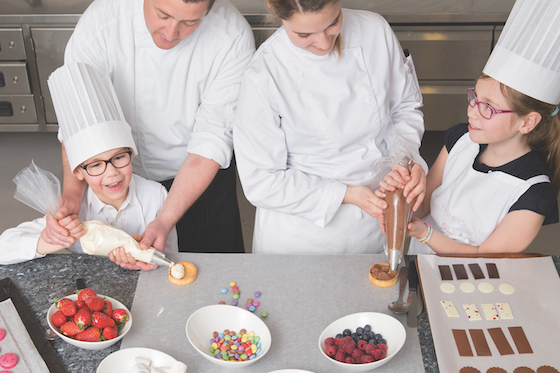Kid’s menus are growing up. While many high-end hotels and resorts still have the obligatory fried chicken tenders and bland pastas, savvy chefs and F&B operators now offer healthier and more adventurous options for their littlest guests.
“I think there is a huge opportunity for hotels to do better with kid’s menus,” says Guy Rigby, founder and president of Octopus, an international F&B consulting firm in Toronto. Hotels must pay attention to restaurants that do it well, he says, and if they do, “they’ll begin to get kids right.”

Contributed by Jeanette Hurt
At the top of Rigby’s wish list for kid’s menus is for hotels to understand the role healthy options play.
“In a healthy family, kids eat healthy food just as their parents do,” says Haim Spiegel, F&B director for Dan Hotels in Israel. That’s not to say that all families want healthy options or that those who opt to eat healthy don’t also want to indulge on vacation.
“They’re asking for more vegetables — colorful vegetables of green, purple, white and orange,” Spiegel says. “They’re also eating much more vegetarian foods than meats, and when they do eat meat, they enjoy better kinds of meat and meats that are prepared healthier like shawarma, which is roasted on a spit.”
“Kids are more sensitive to their health than ever before,” says Sandro Gamba, executive chef at the Rosewood Hotel, Hong Kong. “This can manifest as being very conscious of what certain foods can bring to them and how they will affect not just their own well-being but also how they affect the well-being of those around them.”
Gamba points out that kids have access to more information than ever. “Today’s kids are incredibly conscious and responsible for the way they eat,” he says. “This will come true not just now, but it will also come through in the choices they make as adults, remembering the programs that stood out to them and that accommodated their evolving needs.”
Remon Alphenaar, “guardian of the experience” or manager of development and F&B for Soneva Fushi, Maldives, says today’s children know what they want. “It’s not like in the old days when they were told what to eat. They speak out. They are very educated about animal rights, sustainability, ethical sourcing.”
More exciting menus
Kids are miniature adults — sort of. “Kids love grown-up food as well,” says Rigby, who recommends introducing them to adult food via a grown-up menu with smaller portions and more approachable price.
That is the practice of the Beau-Rivage Palace Hotel in Lausanne, Switzerland, says Didier Schneiter, executive chef. “Nowadays, children are very curious, more used to traveling, and want to do everything like their parents,” he says. “In our restaurants, we offer all the dishes in a child version: smaller portions with the sauce apart.”
Il Solito, an Italian-American restaurant at Kimpton Hotel Vintage in Portland, Oregon, offers a half-portion of any pasta dish at half price for adventurous children. “(Kids) see what parents are eating and are much more curious and eager to try it,” says Brian Crawford, Il Solito’s general manager.
Ethan McKee, executive chef for the Urbana restaurant at the Kimpton Hotel Palomar in Washington, D.C., says simplicity reigns. “Kids want to be able to recognize what they are eating,” he says. “Simply sautéing, grilling or roasting your ingredients with olive oil or butter and lemon makes it easy to keep them familiar when presenting them.”
Soneva Fushi’s Alphenaar says kids’ menus can be tailored even further. “Through much better understanding of what the children like and what they need, our menus have evolved to age-?specific menu offerings,” he says. “There are not region-specific differences. It’s more about the age.”
For younger children, presentation is important — color and texture — along with learning and discovery. For older kids, the meals are more like those offered to adults. “We keep it interactive,” Schneiter says. “If you can achieve that, you get the best results.”
While teens, Alphenaar says, often enjoy comfort foods like pizza and pasta, they still need sophistication. “Most of the children eat in the best restaurants in the world with their parents, so they have very high standards,” he says.
